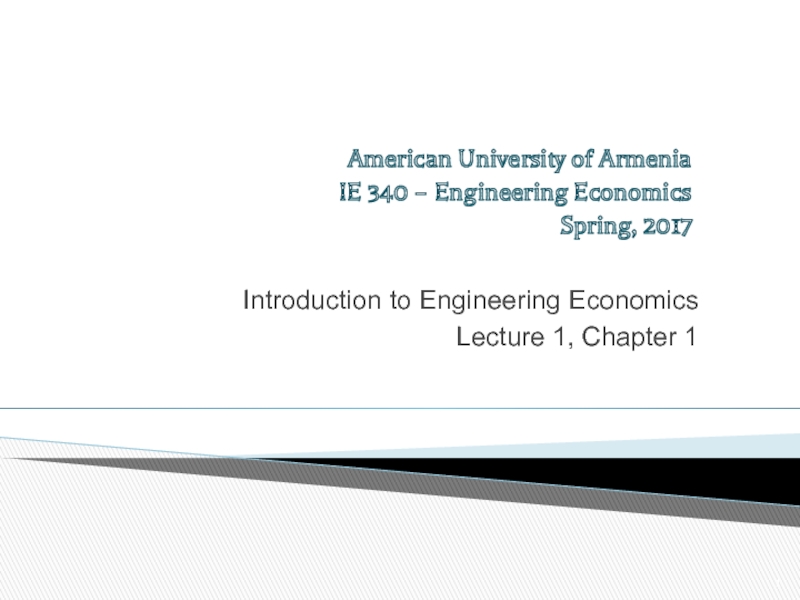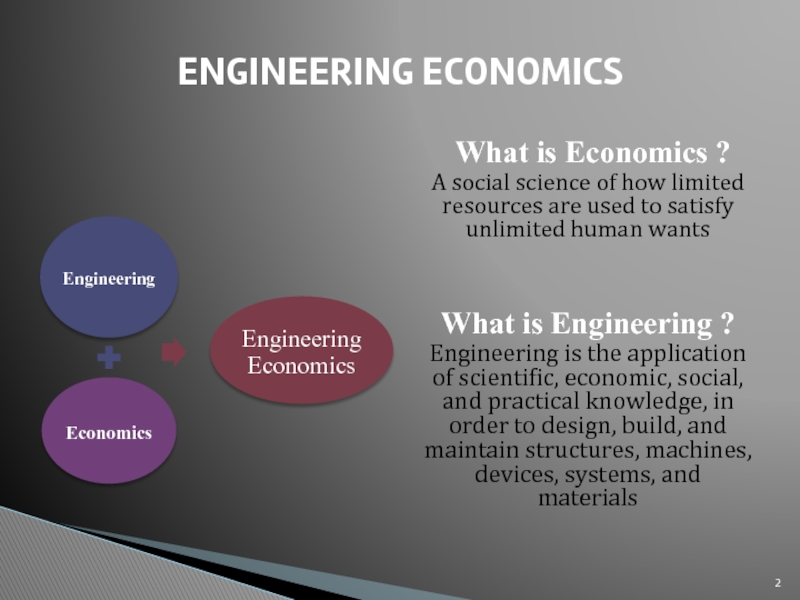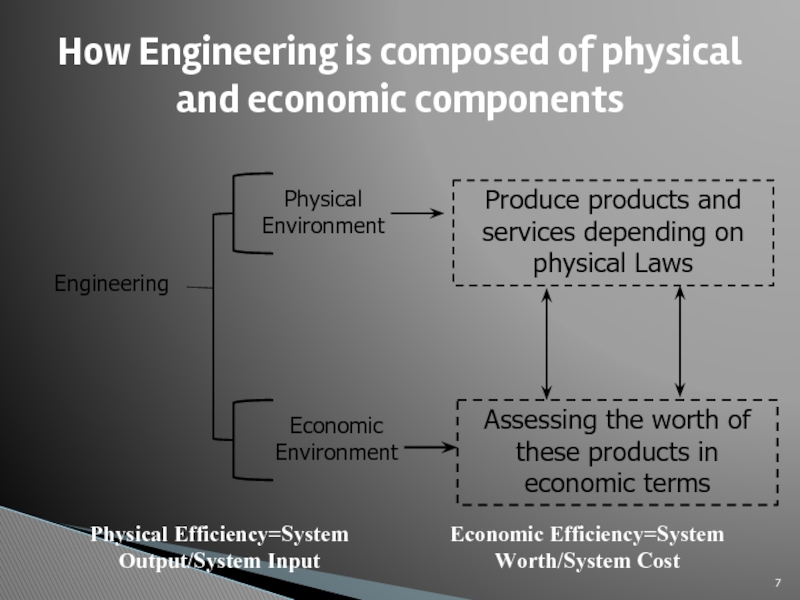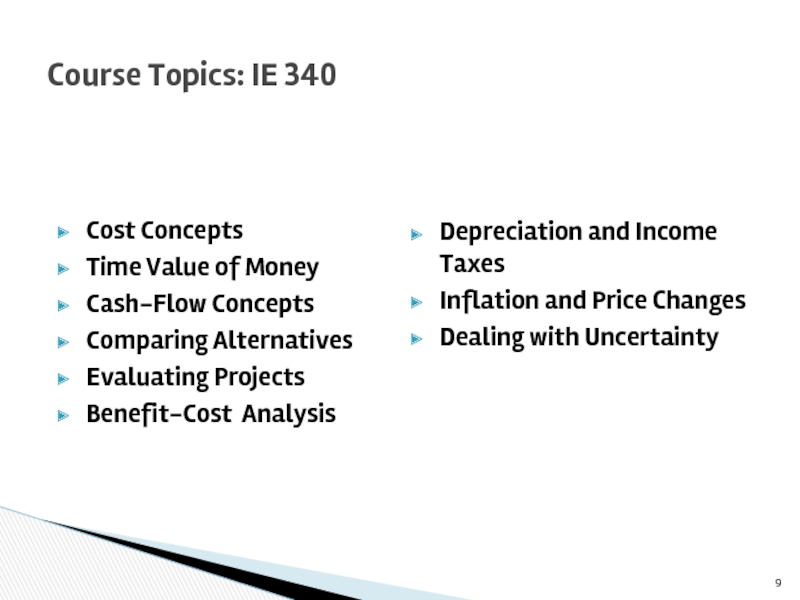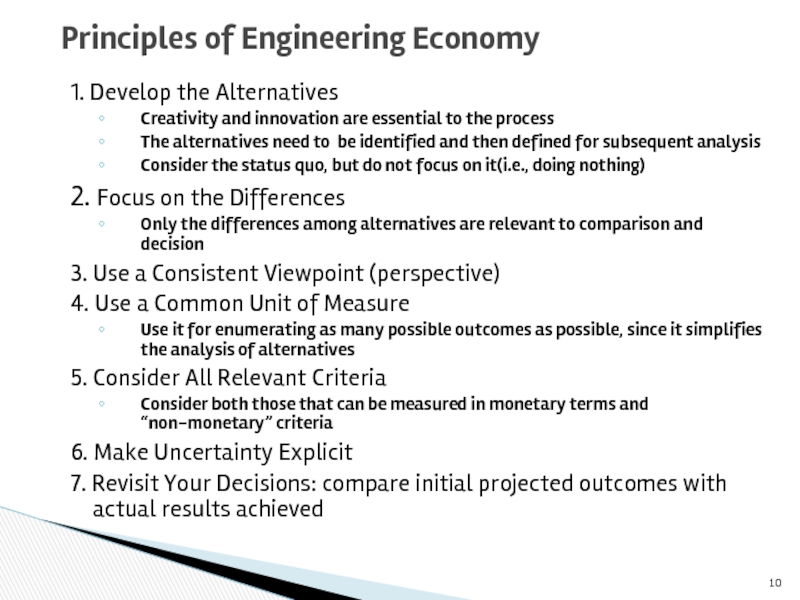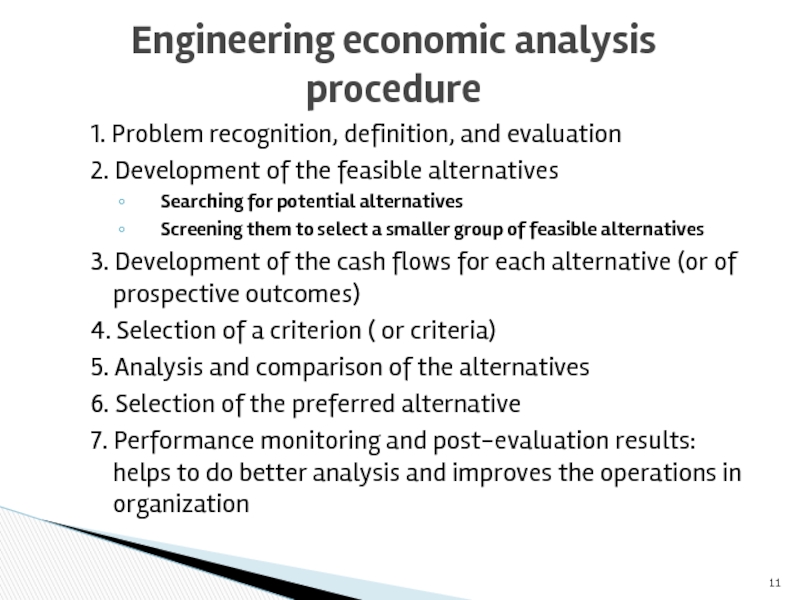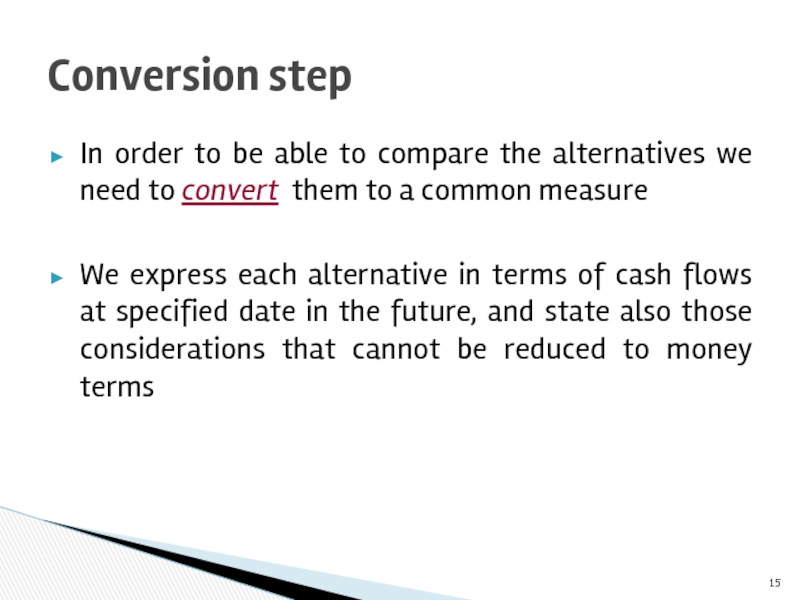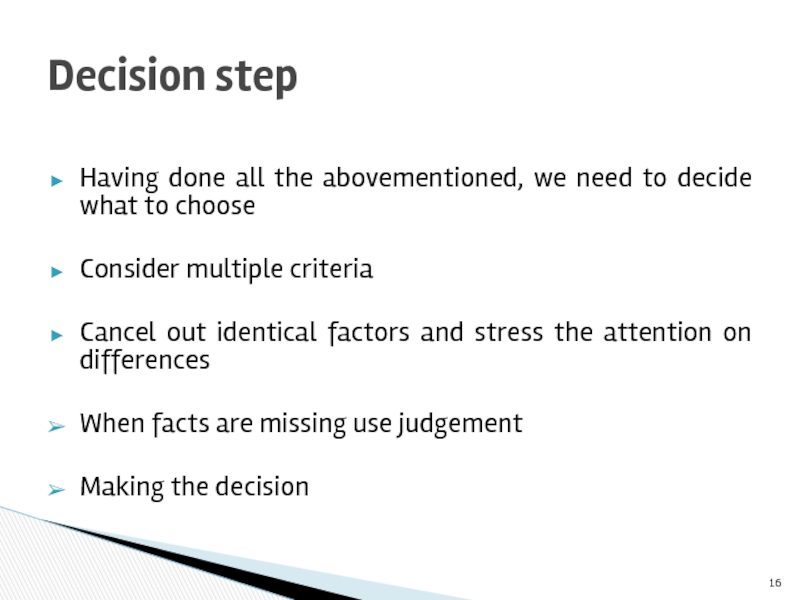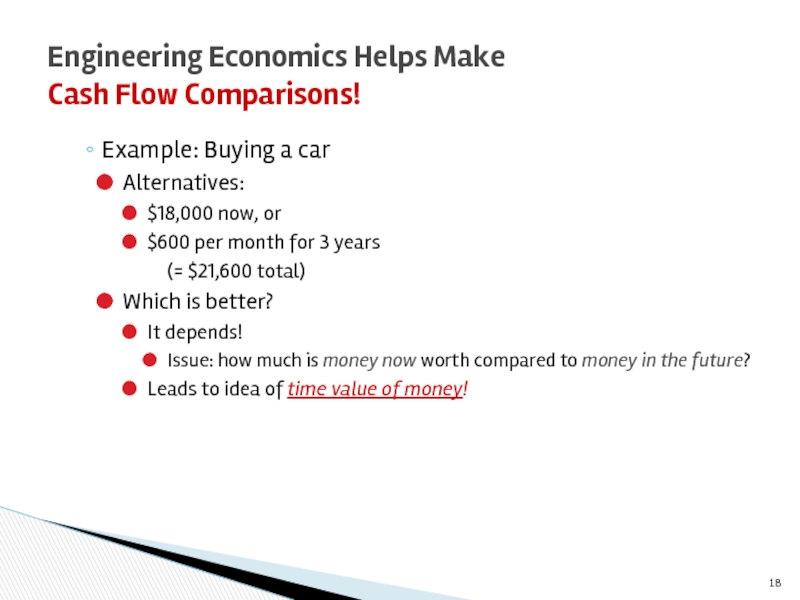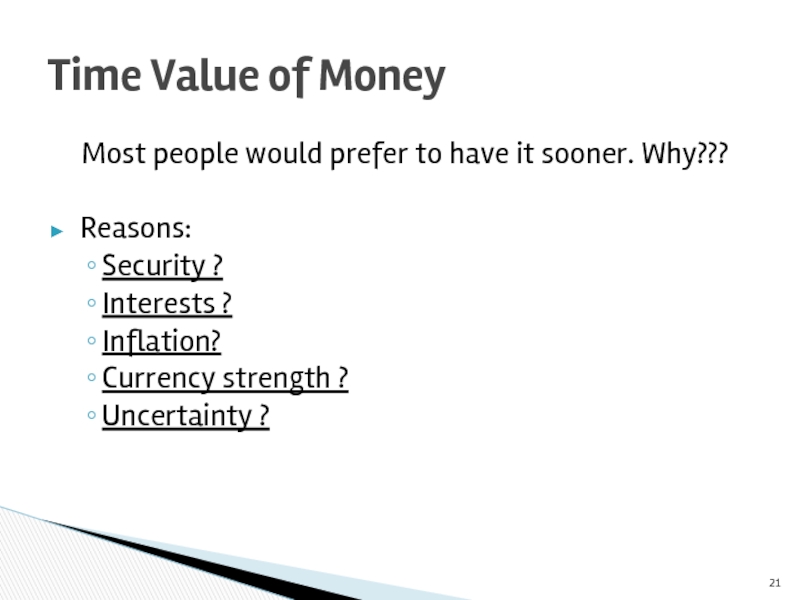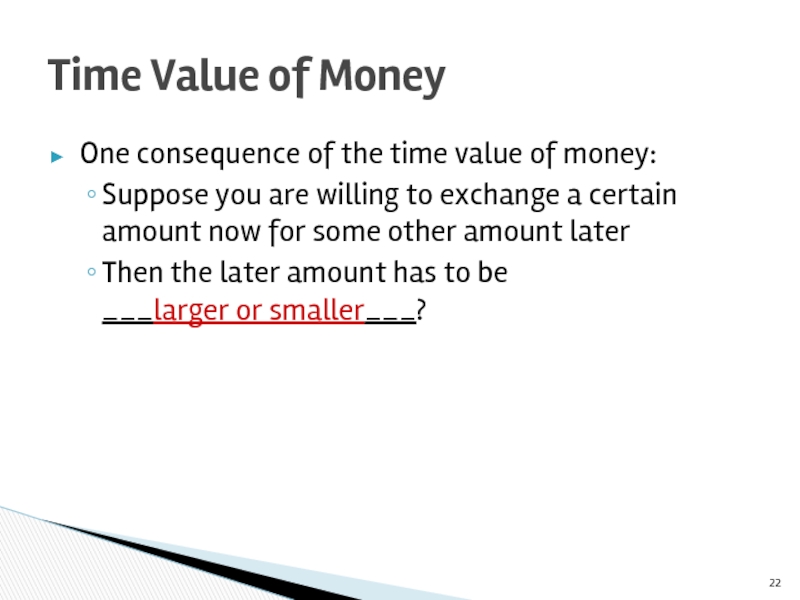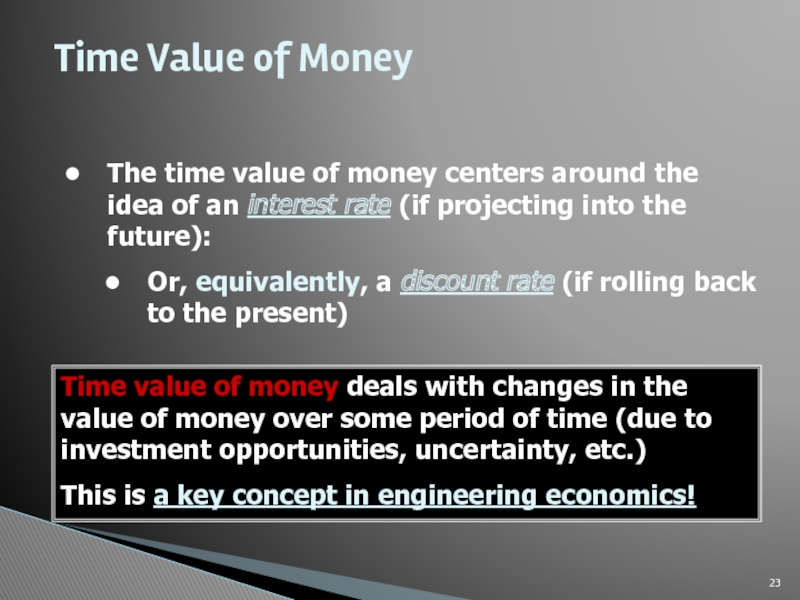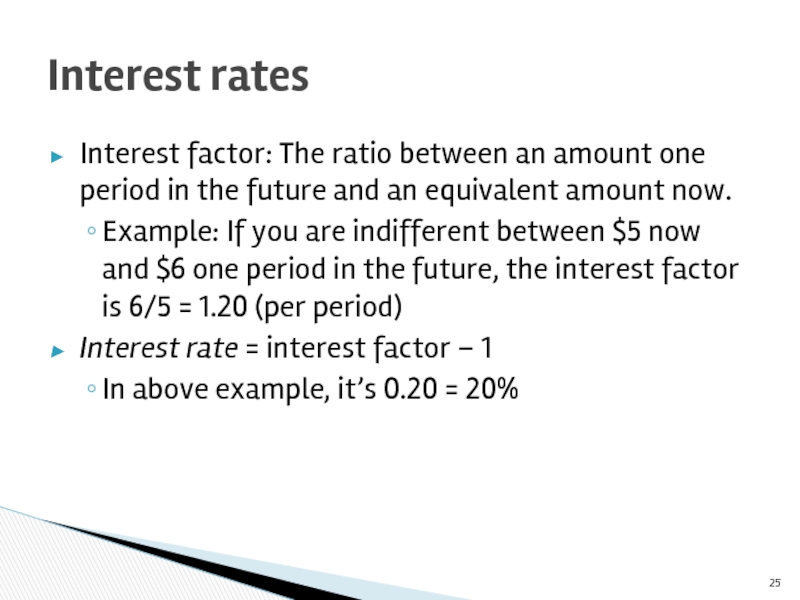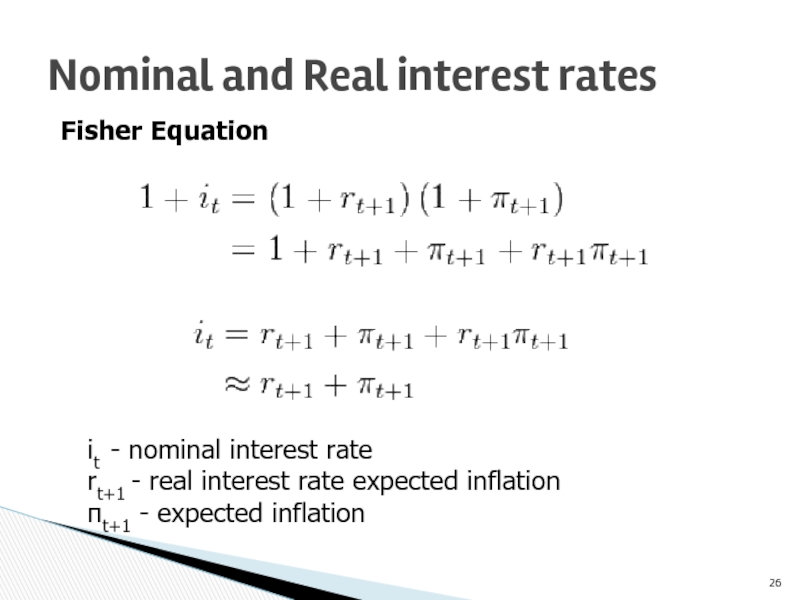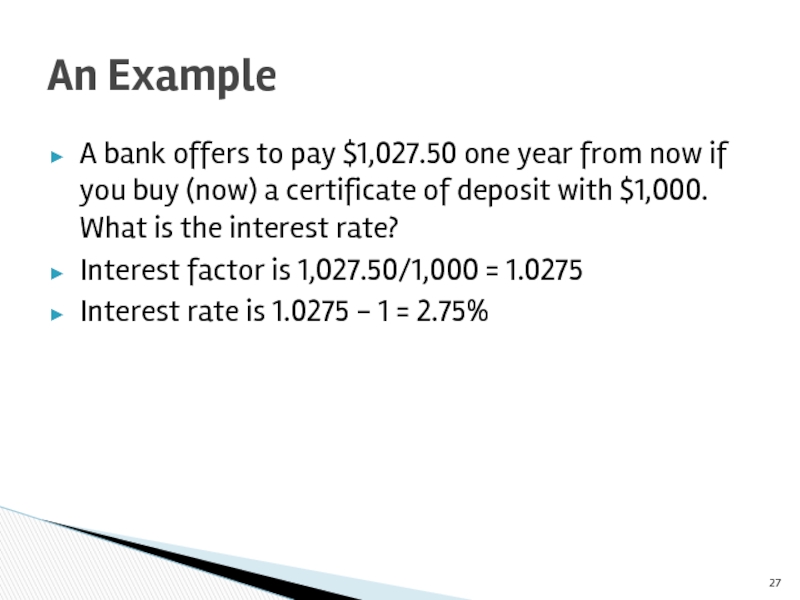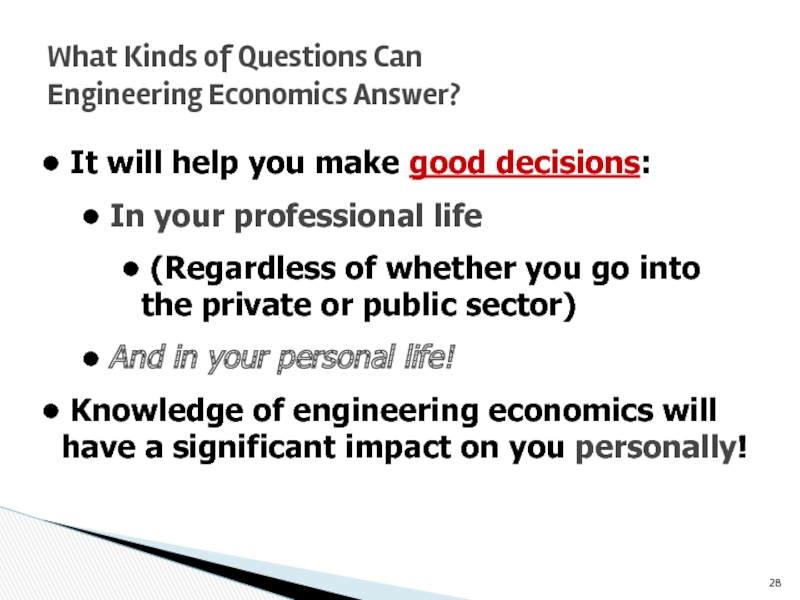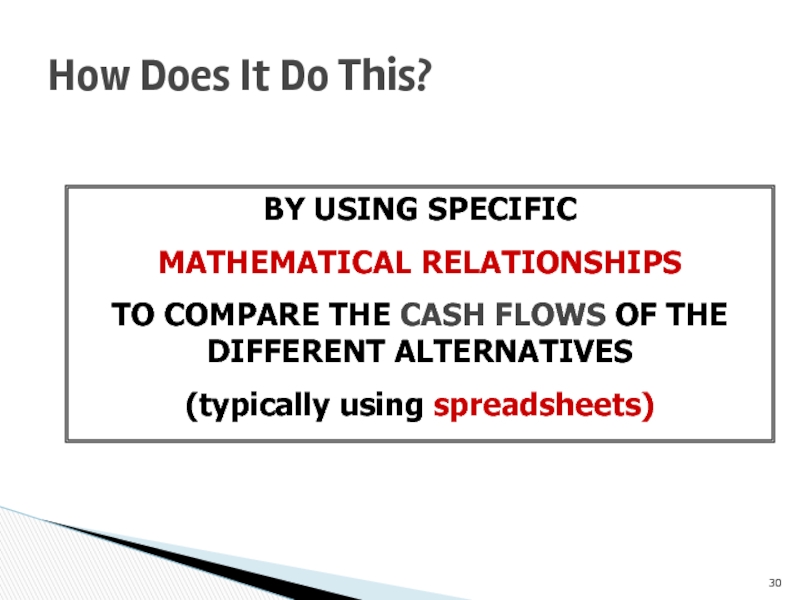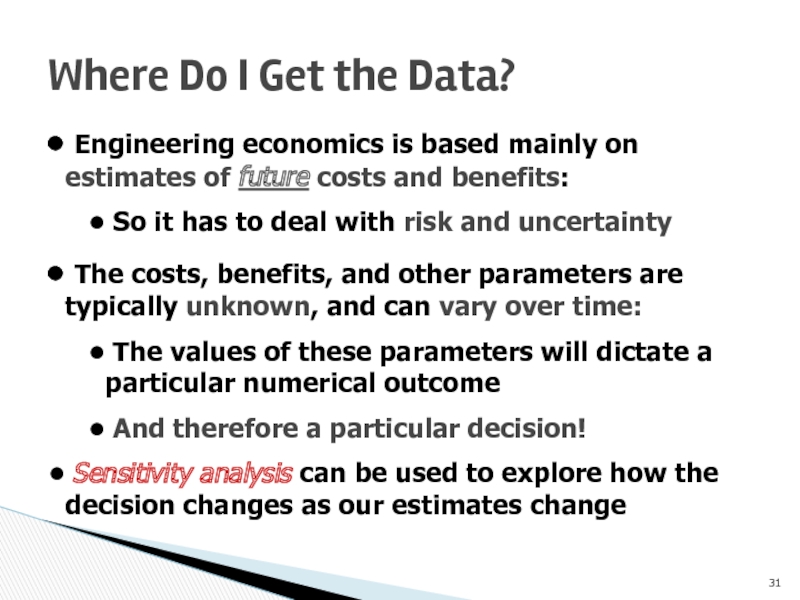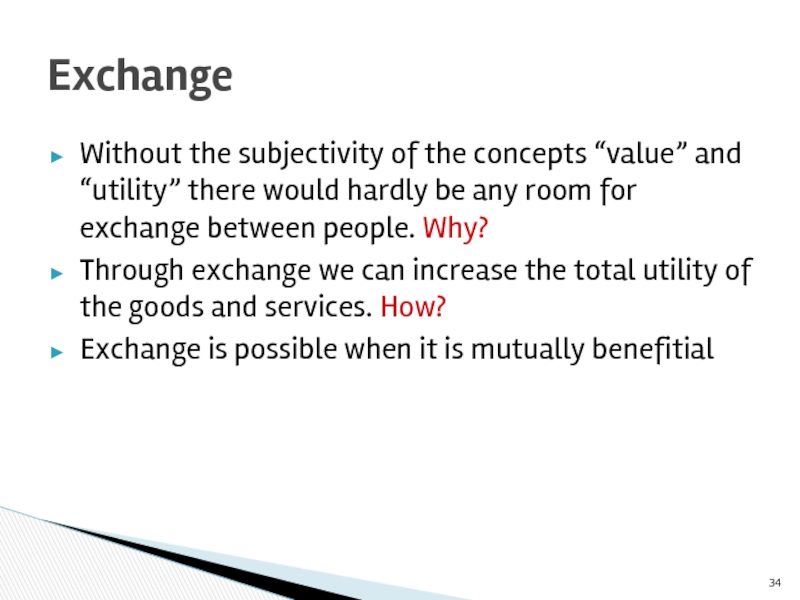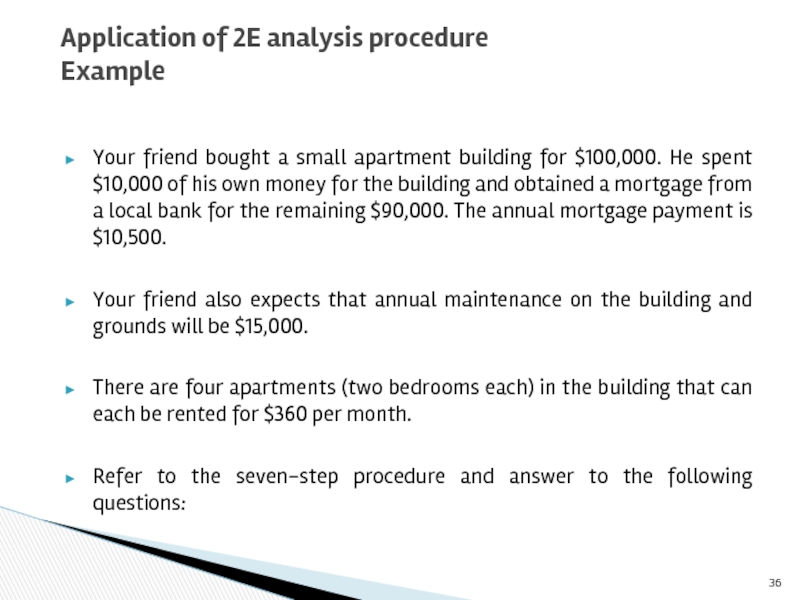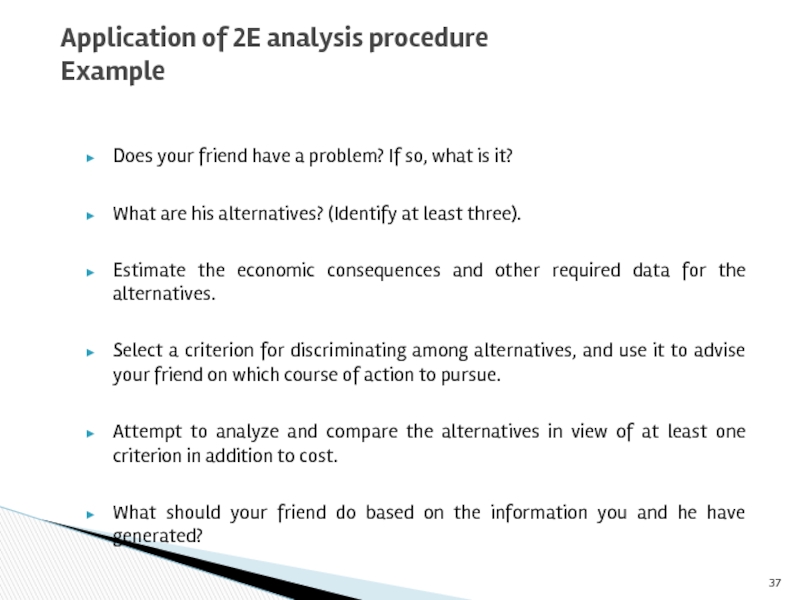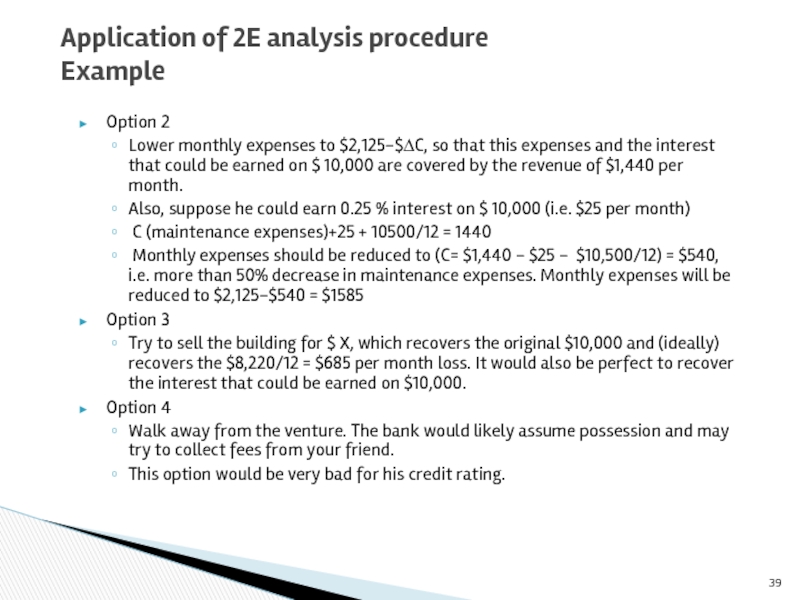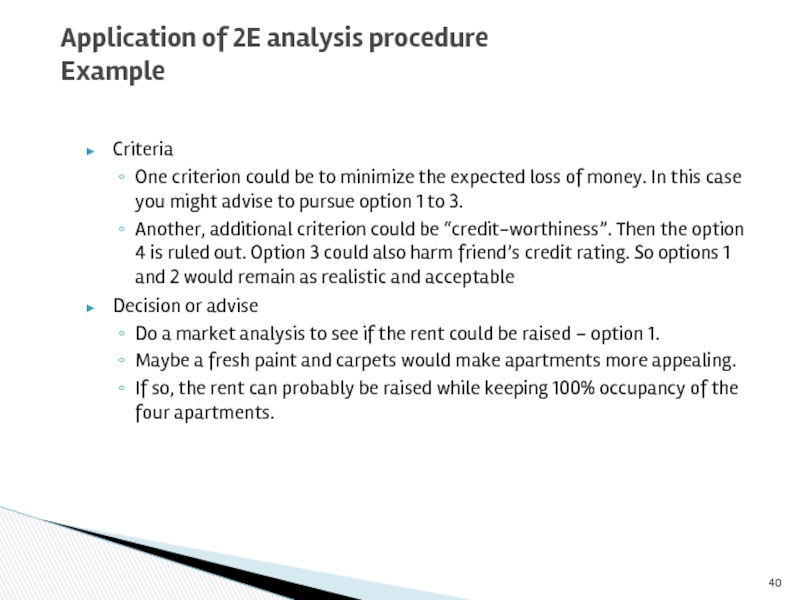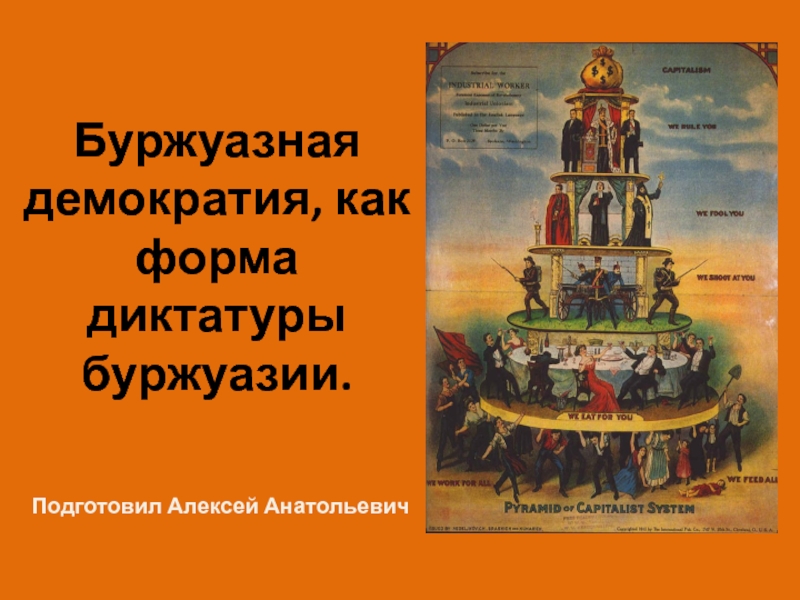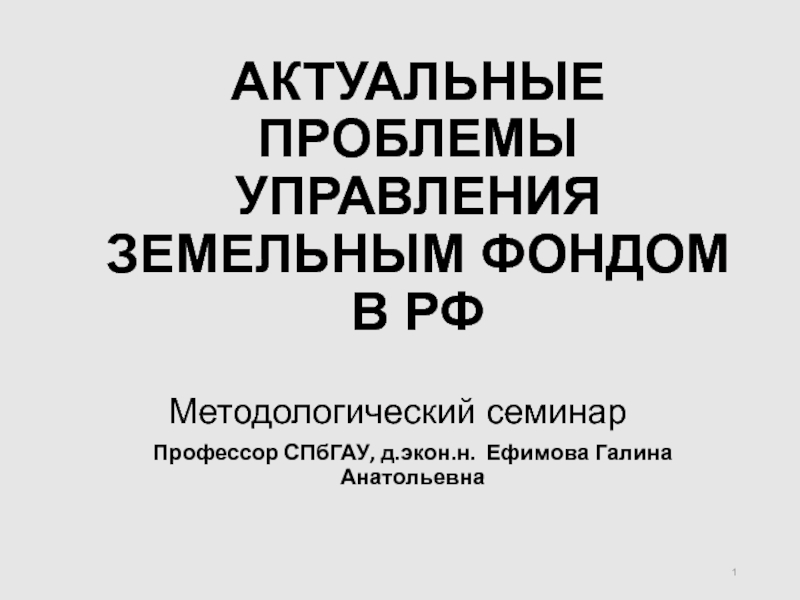- Главная
- Разное
- Дизайн
- Бизнес и предпринимательство
- Аналитика
- Образование
- Развлечения
- Красота и здоровье
- Финансы
- Государство
- Путешествия
- Спорт
- Недвижимость
- Армия
- Графика
- Культурология
- Еда и кулинария
- Лингвистика
- Английский язык
- Астрономия
- Алгебра
- Биология
- География
- Детские презентации
- Информатика
- История
- Литература
- Маркетинг
- Математика
- Медицина
- Менеджмент
- Музыка
- МХК
- Немецкий язык
- ОБЖ
- Обществознание
- Окружающий мир
- Педагогика
- Русский язык
- Технология
- Физика
- Философия
- Химия
- Шаблоны, картинки для презентаций
- Экология
- Экономика
- Юриспруденция
Engineering economics презентация
Содержание
- 1. Engineering economics
- 2. What is Economics ? A
- 3. Resources All gifts of nature, such as:
- 4. Engineering Economics, previously known as engineering
- 5. WHY DO ENGINEERS NEED TO LEARN ABOUT
- 6. What is Engineering Economics? Engineering
- 7. How Engineering is composed of physical and
- 8. Engineering Economics: Origins The development of EI
- 9. Cost Concepts Time
- 10. 1. Develop the Alternatives Creativity and innovation
- 11. 1. Problem recognition, definition, and evaluation 2.
- 12. Four essential steps in formulaing engineering
- 13. The creative step consists of finding an
- 14. In the definition step, we define the
- 15. In order to be able to compare
- 16. Having done all the abovementioned, we
- 17. Engineering economics is needed for many kinds
- 18. Example: Buying a car Alternatives: $18,000 now,
- 19. Would you rather have: $100 today, or
- 20. Would you rather have: $100 today, or
- 21. Most people would prefer to have it
- 22. One consequence of the time value of
- 23. Time Value of Money The time value
- 24. In this course, we will learn methods
- 25. Interest factor: The ratio between an amount
- 26. Nominal and Real interest rates Fisher Equation
- 27. A bank offers to pay $1,027.50 one
- 28. What Kinds of Questions Can Engineering
- 29. What Kinds of Questions Can Engineering
- 30. How Does It Do This? BY USING
- 31. Where Do I Get the Data?
- 32. SOME BASIC ECONOMIC CONCEPTS
- 33. Value is the worth that a person
- 34. Without the subjectivity of the concepts “value”
- 35. What If I Don’t Like the Answers?
- 36. Your friend bought a small apartment building
- 37. Does your friend have a problem? If
- 38. Your friend spends each year $10,500 +
- 39. Option 2 Lower monthly expenses to $2,125-$∆C,
- 40. Criteria One criterion could be to minimize
Слайд 1American University of Armenia
IE 340 – Engineering Economics
Spring, 2017
Introduction to Engineering
Lecture 1, Chapter 1
Слайд 2 What is Economics ?
A social science of how limited
What is Engineering ?
Engineering is the application of scientific, economic, social, and practical knowledge, in order to design, build, and maintain structures, machines, devices, systems, and materials
ENGINEERING ECONOMICS
Слайд 3Resources
All gifts of nature, such as: water, air, minerals, sunshine, plant
The efforts, skills, and knowledge of people which are applied to the production process.
LAND OR NATURAL RESOURCES
LABOR
Real Capital (Physical Capital )
Tools, buildings, machinery -- things which have been produced which are used in further production
Financial Capital
Assets and money which are used in the production process
Human Capital
Education and training applied to labor in the production process.
CAPITAL
$$
Слайд 4
Engineering Economics, previously known as engineering economy, is a subset of
$$
$$
$$
$$
Слайд 5WHY DO ENGINEERS NEED TO LEARN ABOUT ECONOMICS?
Ages ago, the most
Natural resources (from which we must build things) are becoming more scarce and more expensive
Negative side-effects of engineering innovations (such as air pollution from automobiles)
Engineers must decide if the benefits of a project exceed its costs, and must make this comparison in a unified framework. The framework within which to make this comparison is the field of engineering economics, which strives to answer exactly these questions, and perhaps more.
Слайд 6What is Engineering Economics?
Engineering Economics is about making decisions
Engineering
Engineering Economics assesses the appropriateness of a given project, estimates its value, and justifies it from an engineering standpoint
Слайд 7How Engineering is composed of physical and economic components
Engineering
Assessing the worth
Produce products and services depending on physical Laws
Physical Environment
Economic Environment
Physical Efficiency=System Output/System Input
Economic Efficiency=System Worth/System Cost
Слайд 8Engineering Economics: Origins
The development of EI methodology is relatively recent
A pioneer
This early work was followed by other contributions in which the emphasis was put on techniques that depended on financial mathematics. In 1930, Eugene Grant published a textbook which was a milestone in the development of engineering economy as we know it today (economic point of view of engineering)
In 1942 Woods and DeGarmo wrote a book, later titled Engineering Economy
Слайд 9
Cost Concepts
Time Value of Money
Cash-Flow Concepts
Comparing Alternatives
Evaluating Projects
Benefit-Cost Analysis
Course Topics:
Depreciation and Income Taxes
Inflation and Price Changes
Dealing with Uncertainty
Слайд 101. Develop the Alternatives
Creativity and innovation are essential to the process
The
Consider the status quo, but do not focus on it(i.e., doing nothing)
2. Focus on the Differences
Only the differences among alternatives are relevant to comparison and decision
3. Use a Consistent Viewpoint (perspective)
4. Use a Common Unit of Measure
Use it for enumerating as many possible outcomes as possible, since it simplifies the analysis of alternatives
5. Consider All Relevant Criteria
Consider both those that can be measured in monetary terms and “non-monetary” criteria
6. Make Uncertainty Explicit
7. Revisit Your Decisions: compare initial projected outcomes with actual results achieved
Principles of Engineering Economy
Слайд 111. Problem recognition, definition, and evaluation
2. Development of the feasible alternatives
Searching
Screening them to select a smaller group of feasible alternatives
3. Development of the cash flows for each alternative (or of prospective outcomes)
4. Selection of a criterion ( or criteria)
5. Analysis and comparison of the alternatives
6. Selection of the preferred alternative
7. Performance monitoring and post-evaluation results: helps to do better analysis and improves the operations in organization
Engineering economic analysis procedure
Слайд 12 Four essential steps in formulaing engineering economic decisions are:
Creative step:
Definition step: define all factors associated with each alternative originated in creative step
Conversion step:
Decision step
Simpler procedure for formulating engineering economic decisions
Слайд 13The creative step consists of finding an opening through a barrier
We explore, investigate and research aiming at finding new opportunitites
Many successful ideas are simply new combinations of known facts
Creative step
Слайд 14In the definition step, we define the alternatives originated or selected
Choice is always between alternatives, but we also need to choose which alternatives to consider
Is it better to spend more time defining more possible alternatives or to take the decision fast considering only few?
Definition step
Слайд 15In order to be able to compare the alternatives we need
We express each alternative in terms of cash flows at specified date in the future, and state also those considerations that cannot be reduced to money terms
Conversion step
Слайд 16
Having done all the abovementioned, we need to decide what to
Consider multiple criteria
Cancel out identical factors and stress the attention on differences
When facts are missing use judgement
Making the decision
Decision step
Слайд 17Engineering economics is needed for many kinds of decision making
Example: Buying
Alternatives:
$18,000 now, or
$600 per month for 3 years
Which is better?
What Kinds of Questions Can
Engineering Economics Answer?
An example
Слайд 18Example: Buying a car
Alternatives:
$18,000 now, or
$600 per month for 3 years
(= $21,600 total)
Which is better?
It depends!
Issue: how much is money now worth compared to money in the future?
Leads to idea of time value of money!
Engineering Economics Helps Make
Cash Flow Comparisons!
Слайд 20Would you rather have:
$100 today, or
$100 a year from now?
Basic
Given a fixed amount of money, and
A choice of having it now or in the future,
Most people would prefer to have it sooner rather than later
Time Value of Money
Слайд 21Most people would prefer to have it sooner. Why???
Reasons:
Security ?
Interests
Inflation?
Currency strength ?
Uncertainty ?
Time Value of Money
Слайд 22One consequence of the time value of money:
Suppose you are
Then the later amount has to be ___larger or smaller___?
Time Value of Money
Слайд 23Time Value of Money
The time value of money centers around the
Or, equivalently, a discount rate (if rolling back to the present)
Time value of money deals with changes in the value of money over some period of time (due to investment opportunities, uncertainty, etc.)
This is a key concept in engineering economics!
Слайд 24In this course, we will learn methods to:
Compare different cash flows
Using the interest rate or discount rate:
How much more a dollar today is worth compared to a dollar in one year
For example, if the interest rate is 5%:
$1 today is worth as much as $1.05 next year
What Does This Mean for Us?
Слайд 25Interest factor: The ratio between an amount one period in the
Example: If you are indifferent between $5 now and $6 one period in the future, the interest factor is 6/5 = 1.20 (per period)
Interest rate = interest factor – 1
In above example, it’s 0.20 = 20%
Interest rates
Слайд 26Nominal and Real interest rates
Fisher Equation
it - nominal interest rate
rt+1 -
πt+1 - expected inflation
Слайд 27A bank offers to pay $1,027.50 one year from now if
Interest factor is 1,027.50/1,000 = 1.0275
Interest rate is 1.0275 - 1 = 2.75%
An Example
Слайд 28What Kinds of Questions Can
Engineering Economics Answer?
It will help
In your professional life
(Regardless of whether you go into the private or public sector)
And in your personal life!
Knowledge of engineering economics will have a significant impact on you personally!
Слайд 29What Kinds of Questions Can
Engineering Economics Answer?
ENGINEERING ECONOMICS INVOLVES:
FORMULATING, ESTIMATING, AND EVALUATING ECONOMIC OUTCOMES
WHEN CHOICES OR ALTERNATIVES ARE AVAILABLE
Слайд 30How Does It Do This?
BY USING SPECIFIC
MATHEMATICAL RELATIONSHIPS
TO COMPARE
(typically using spreadsheets)
Слайд 31Where Do I Get the Data?
Engineering economics is based mainly
So it has to deal with risk and uncertainty
The costs, benefits, and other parameters are typically unknown, and can vary over time:
The values of these parameters will dictate a particular numerical outcome
And therefore a particular decision!
Sensitivity analysis can be used to explore how the decision changes as our estimates change
Слайд 33Value is the worth that a person attaches to a good
Value is inherent in a regard a person has for it, not in the item itself
Value is not the cost of the item
Utility is a power to satisfy human wants and is determined subjectively
Utility is the satisfaction that a person derives from an item
Value and Utility
Слайд 34Without the subjectivity of the concepts “value” and “utility” there would
Through exchange we can increase the total utility of the goods and services. How?
Exchange is possible when it is mutually benefitial
Exchange
Слайд 35What If I Don’t Like the Answers?
Remember:
“Tools” don’t
People make decisions, based on values
Engineering economics is just a set of tools:
It can help in decision making
But it won’t make the decision for you
Which alternative is “best” is up to you!
Слайд 36Your friend bought a small apartment building for $100,000. He spent
Your friend also expects that annual maintenance on the building and grounds will be $15,000.
There are four apartments (two bedrooms each) in the building that can each be rented for $360 per month.
Refer to the seven-step procedure and answer to the following questions:
Application of 2E analysis procedure
Example
Слайд 37Does your friend have a problem? If so, what is it?
What
Estimate the economic consequences and other required data for the alternatives.
Select a criterion for discriminating among alternatives, and use it to advise your friend on which course of action to pursue.
Attempt to analyze and compare the alternatives in view of at least one criterion in addition to cost.
What should your friend do based on the information you and he have generated?
Application of 2E analysis procedure
Example
Слайд 38Your friend spends each year $10,500 + $15,000 = $25,500, but
He is losing $8,220 each year – this is the problem!
Options
Raise the rent (Will the market bear an increase?)
Lower maintenance expenses (but not so far as to cause safety problems)
Sell the apartment building (What about a loss?)
Abandon the building (bad for your friends reputation)
Option 1
Raise the total rent by $360 X 4 + $ R, to cover monthly expenses $ 2.125 and the interest that could be earned on $ 10,000.
This would imply the minimum increase of the rent per apartment per month by ($2,125 - $1,440)/4 = $171.25, i.e. more that by 50%
Application of 2E analysis procedure
Example
Слайд 39Option 2
Lower monthly expenses to $2,125-$∆C, so that this expenses and
Also, suppose he could earn 0.25 % interest on $ 10,000 (i.e. $25 per month)
C (maintenance expenses)+25 + 10500/12 = 1440
Monthly expenses should be reduced to (C= $1,440 - $25 - $10,500/12) = $540, i.e. more than 50% decrease in maintenance expenses. Monthly expenses will be reduced to $2,125-$540 = $1585
Option 3
Try to sell the building for $ X, which recovers the original $10,000 and (ideally) recovers the $8,220/12 = $685 per month loss. It would also be perfect to recover the interest that could be earned on $10,000.
Option 4
Walk away from the venture. The bank would likely assume possession and may try to collect fees from your friend.
This option would be very bad for his credit rating.
Application of 2E analysis procedure
Example
Слайд 40Criteria
One criterion could be to minimize the expected loss of money.
Another, additional criterion could be “credit-worthiness”. Then the option 4 is ruled out. Option 3 could also harm friend’s credit rating. So options 1 and 2 would remain as realistic and acceptable
Decision or advise
Do a market analysis to see if the rent could be raised – option 1.
Maybe a fresh paint and carpets would make apartments more appealing.
If so, the rent can probably be raised while keeping 100% occupancy of the four apartments.
Application of 2E analysis procedure
Example
